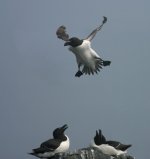mjmw
formally known as mw_aurora
This is a continuation of a thread I stupidly started in the gallery instead of here - wasn't thinking straight!
Gallery Picture
I have also attached the picture here and this is the description:
Bored this afternoon having failed to get any pleasing shots in today's snow (at last!). So I dug out a shot I have been meaning to work up and manipulate. Now I know that not everybody will see this as 'ethical' but I personally do not see a problem - this is a single photo, processed from RAW, then standard PP in photoshop...however, I also moved the flying Razorbill a little to the right to improve composition and cloned out an OOF bird from bottom right. This was only a few minutes work...so what do you think? If declared, does it really matter?
Gallery Picture
I have also attached the picture here and this is the description:
Bored this afternoon having failed to get any pleasing shots in today's snow (at last!). So I dug out a shot I have been meaning to work up and manipulate. Now I know that not everybody will see this as 'ethical' but I personally do not see a problem - this is a single photo, processed from RAW, then standard PP in photoshop...however, I also moved the flying Razorbill a little to the right to improve composition and cloned out an OOF bird from bottom right. This was only a few minutes work...so what do you think? If declared, does it really matter?




